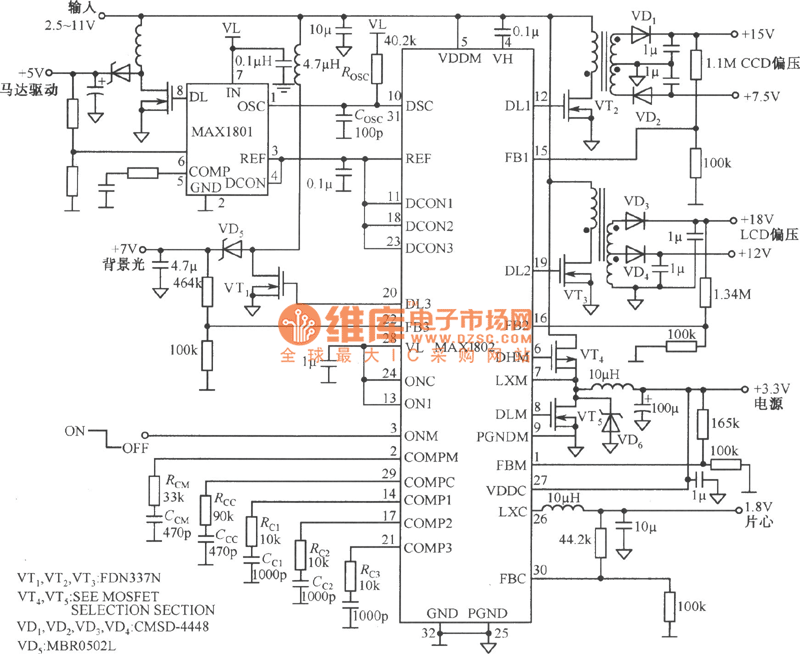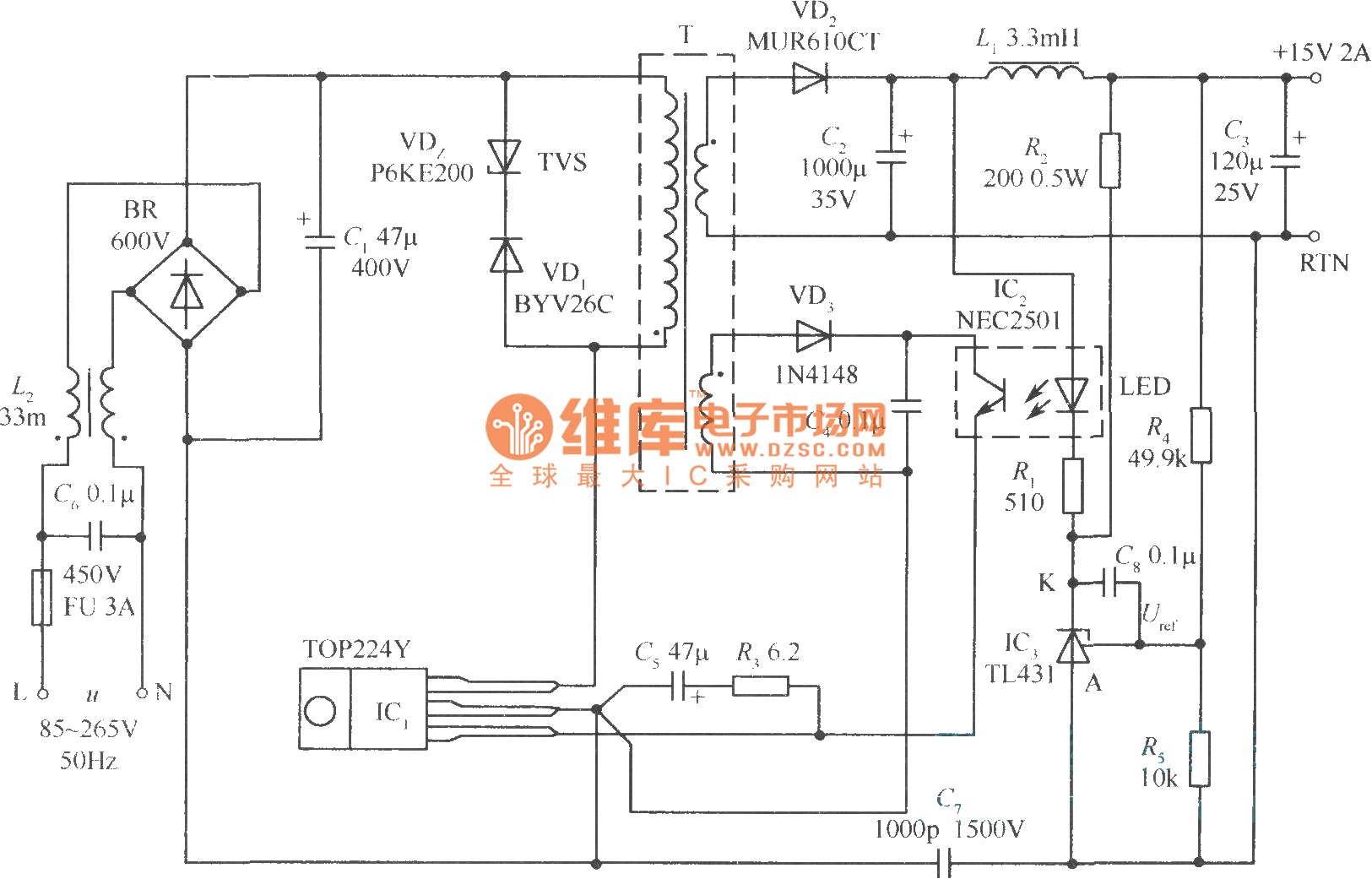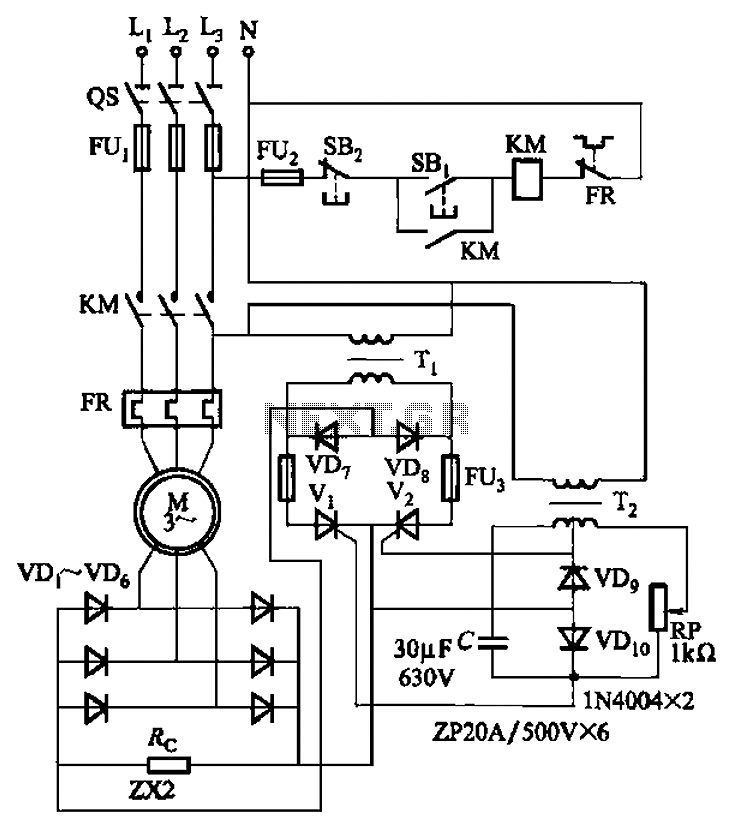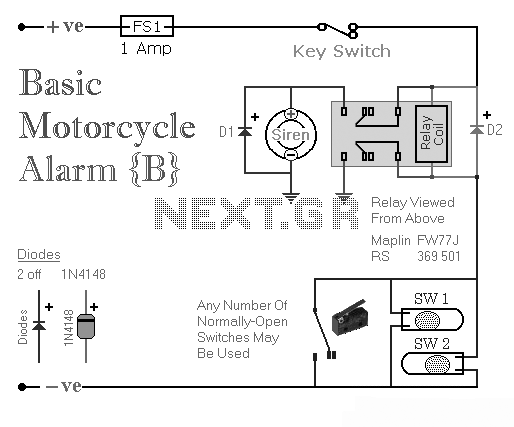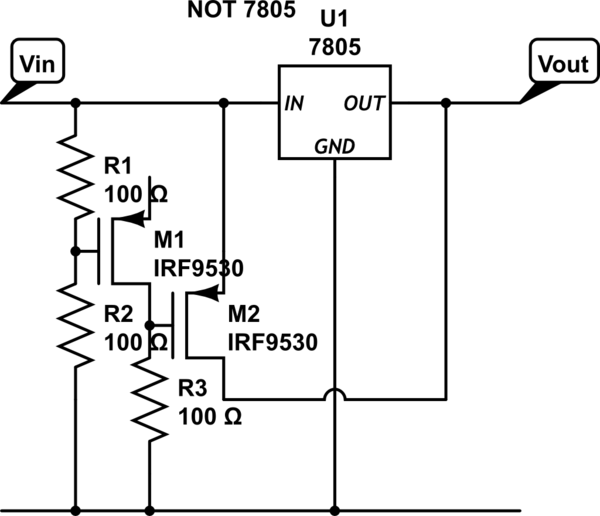
Mains Supply Failure Alarm
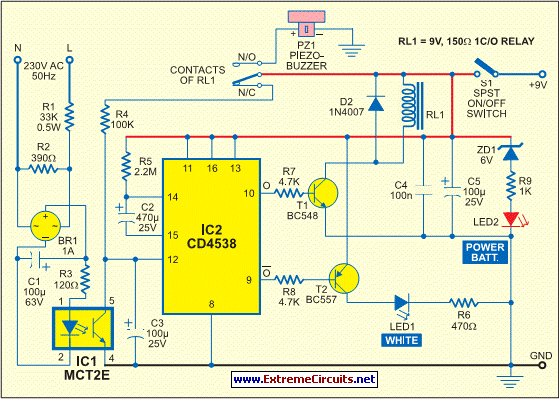
This circuit alerts users when the AC mains supply fails by sounding an alarm and providing a backup light to aid in locating a torch or generator key in the dark. It is powered directly by a 9V PP3/6F22 compact battery. The circuit is activated by pressing switch S1, which supplies 9V power. A red LED (LED2) in conjunction with a zener diode (ZD1, 6V) indicates the battery power level. Resistor R9 limits the operating current and brightness of LED2; it glows with full intensity at 9V, dims below 8V, and turns off below 7.5V. In standby mode, both LEDs are off, and the buzzer is silent. The 230V AC mains is fed to the mains voltage detection optocoupler IC MCT2E (IC1) through resistors R1, R2, R3, a bridge rectifier (BR1), and capacitor C1. Illumination of the LED inside IC1 activates its internal phototransistor, pulling clock input pin 12 of IC2 low (connected to 9V via the N/C contact of relay RL1). Only one monostable of the dual-monostable multivibrator IC CD4538 (IC2) is utilized. When the mains supply fails, IC2 is triggered after a delay determined by components C1, R4, and C3. Output pin 10 of IC2 goes high, forward biasing relay driver transistor T1 through resistor R7, energizing relay RL1 to activate the piezo buzzer via its N/O contact for approximately 17 minutes. The N/C contact simultaneously removes the positive supply to resistor R4. The duration of the monostable multivibrator is defined by R5 and C2. Output pin 9 of IC2 goes low, forward biasing PNP transistor T2 to illuminate the white LED (LED1), providing sufficient light to locate the torch or generator key. The circuit can be turned off during the timeout period by opening switch S1. The duration of the monostable multivibrator can be adjusted by changing the values of resistor R5 or capacitor C2. If the mains does not resume when the timeout period ends, the timer is retriggered after a brief delay determined by resistors R4 and C3.
The circuit operates as a reliable alert system for power outages, combining alarm and illumination functionalities for user convenience. The use of a compact 9V battery ensures portability and ease of use. The optocoupler IC MCT2E plays a crucial role in detecting the presence of AC mains voltage, ensuring that the circuit is only active when necessary. The design incorporates safety features such as the use of a bridge rectifier to manage AC input, converting it to a usable DC signal for the rest of the circuit.
The monostable multivibrator IC CD4538 is utilized effectively to create a time delay for the alarm and light activation, allowing users ample time to respond to the power failure. The adjustable timeout period provides flexibility, enabling customization based on user needs. The inclusion of a piezo buzzer ensures that the alarm is audible even in low-light conditions, while the white LED serves as a practical solution for locating essential items in the dark.
Overall, this circuit exemplifies a well-thought-out design that addresses the critical need for alerts and illumination during power outages, enhancing safety and convenience for users.Whenever AC mains supply fails, this circuit alerts you by sounding an alarm. It also provides a backup light to help you find your way to the torch or the generator key in the dark. The circuit is powered directly by a 9V PP3/6F22 compact battery. Pressing of switch S1 provides the 9V power supply to the circuit. A red LED (LED2), in conjunctio n with zener diode ZD1 (6V), is used to indicate the battery power level. Resistor R9 limits the operating current (and hence the brightness) of LED2. When the battery voltage is 9V, LED2 glows with full intensity. As the battery voltage goes below 8V, the intensity of LED2 decreases and it glows very dimly. LED2 goes off when the battery voltage goes below 7. 5V. Initially, in standby state, both the LEDs are off and the buzzer does not sound. The 230V AC mains is directly fed to mains-voltage detection optocoupler IC MCT2E (IC1) via resistors R1, R2 and R3, bridge rectifier BR1 and capacitor C1. Illumination of the LED inside optocoupler IC1 activates its internal phototransistor and clock input pin 12 of IC2 (connected to 9V via N/C contact of relay RL1) is pulled low.
Note that only one monostable of dual-monostable multivibrator IC CD4538 (IC2) is used here. When mains goes off, IC2 is triggered after a short duration determined by components C1, R4 and C3. Output pin 10 of IC2 goes high to forward bias relay driver transistor T1 via resistor R7. Relay RL1 energises to activate the piezo buzzer via its N/O contact for the time-out period of the monostable multivibrator (approximately 17 minutes). At the same time, the N/C contact removes the positive supply to resistor R4. The time-out period of the monostable multivibrator is determined by R5 and C2. Simultaneously, output pin 9 of IC2 goes low and pnp transistor T2 gets forward biased to light up the white LED (LED1).
Light provided by this back-up LED is sufficient to search the torch or generator key. During the mono time-out period, the circuit can be switched off by opening switch S1. The on` period of the monostable multivibrator may be changed by changing the value of resistor R5 or capacitor C2. If mains doesn`t resume when the on` period of the monostable lapses, the timer is retriggered after a short delay determined by resistor R4 and C3.
🔗 External reference
The circuit operates as a reliable alert system for power outages, combining alarm and illumination functionalities for user convenience. The use of a compact 9V battery ensures portability and ease of use. The optocoupler IC MCT2E plays a crucial role in detecting the presence of AC mains voltage, ensuring that the circuit is only active when necessary. The design incorporates safety features such as the use of a bridge rectifier to manage AC input, converting it to a usable DC signal for the rest of the circuit.
The monostable multivibrator IC CD4538 is utilized effectively to create a time delay for the alarm and light activation, allowing users ample time to respond to the power failure. The adjustable timeout period provides flexibility, enabling customization based on user needs. The inclusion of a piezo buzzer ensures that the alarm is audible even in low-light conditions, while the white LED serves as a practical solution for locating essential items in the dark.
Overall, this circuit exemplifies a well-thought-out design that addresses the critical need for alerts and illumination during power outages, enhancing safety and convenience for users.Whenever AC mains supply fails, this circuit alerts you by sounding an alarm. It also provides a backup light to help you find your way to the torch or the generator key in the dark. The circuit is powered directly by a 9V PP3/6F22 compact battery. Pressing of switch S1 provides the 9V power supply to the circuit. A red LED (LED2), in conjunctio n with zener diode ZD1 (6V), is used to indicate the battery power level. Resistor R9 limits the operating current (and hence the brightness) of LED2. When the battery voltage is 9V, LED2 glows with full intensity. As the battery voltage goes below 8V, the intensity of LED2 decreases and it glows very dimly. LED2 goes off when the battery voltage goes below 7. 5V. Initially, in standby state, both the LEDs are off and the buzzer does not sound. The 230V AC mains is directly fed to mains-voltage detection optocoupler IC MCT2E (IC1) via resistors R1, R2 and R3, bridge rectifier BR1 and capacitor C1. Illumination of the LED inside optocoupler IC1 activates its internal phototransistor and clock input pin 12 of IC2 (connected to 9V via N/C contact of relay RL1) is pulled low.
Note that only one monostable of dual-monostable multivibrator IC CD4538 (IC2) is used here. When mains goes off, IC2 is triggered after a short duration determined by components C1, R4 and C3. Output pin 10 of IC2 goes high to forward bias relay driver transistor T1 via resistor R7. Relay RL1 energises to activate the piezo buzzer via its N/O contact for the time-out period of the monostable multivibrator (approximately 17 minutes). At the same time, the N/C contact removes the positive supply to resistor R4. The time-out period of the monostable multivibrator is determined by R5 and C2. Simultaneously, output pin 9 of IC2 goes low and pnp transistor T2 gets forward biased to light up the white LED (LED1).
Light provided by this back-up LED is sufficient to search the torch or generator key. During the mono time-out period, the circuit can be switched off by opening switch S1. The on` period of the monostable multivibrator may be changed by changing the value of resistor R5 or capacitor C2. If mains doesn`t resume when the on` period of the monostable lapses, the timer is retriggered after a short delay determined by resistor R4 and C3.
🔗 External reference
Warning: include(partials/cookie-banner.php): Failed to open stream: Permission denied in /var/www/html/nextgr/view-circuit.php on line 713
Warning: include(): Failed opening 'partials/cookie-banner.php' for inclusion (include_path='.:/usr/share/php') in /var/www/html/nextgr/view-circuit.php on line 713
